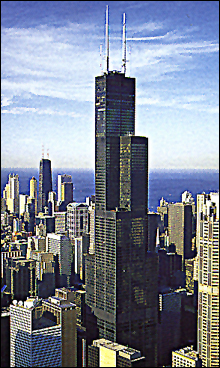
ALL TALK: The “plots” may have been just a bunch of big talk stirred up by the FBI.
|
Sometimes a cigar is just a cigar. Sometimes, however, a “terrorism” prosecution is anything but. Just take a look at two recent, highly publicized federal prosecutions — one alleging a Middle Eastern plot to bomb New York City’s Holland Tunnel, the other a Miami-based conspiracy to take down Chicago’s Sears Tower.
The Miami case, in particular, raised eyebrows because none of the seven young defendants got beyond talking big: they’d obtained neither explosives nor building plans, nor had they undertaken any surveillance. In the New York Times, for instance, Eric Lipton reported skeptically on claims by the Department of Homeland Security and the FBI that they arrested the “conspirators” early in the alleged plots because of a new policy of pre-empting terrorist activities during the “aspirational” phase. And it appears that all the big talk was stirred up by an FBI informant who offered to supply the expertise and materials.
The Holland Tunnel plot was no closer to reality. Neither Assem Hammoud, the 31-year-old Lebanese man accused of being the mastermind, nor any of his alleged henchmen, had ever even visited the US. The “plot” was discovered by monitoring Internet chat rooms. Indeed, American officials admitted that none of the “plotters” had even met one another.
So what’s really driving these so-called “terrorism” prosecutions? One obvious explanation is Public Relations 101: assure the public the administration is on top of national-security in hopes that such crowing will rescue the Republicans from defeat in the midterm congressional elections. But there is another explanation with longer-term significance: these prosecutions may be part of the Department of Justice’s latest legal assault on free speech in the name of defending against terror.
Two currently operable legal doctrines should have stood in the way of these prosecutions, so heavy on rhetoric yet light on evidence. For conviction, federal conspiracy law has traditionally required proof not only that defendants have agreed to commit an illegal act, but also that a step has been taken to bring about the agreed-upon end. Lawyers, prosecutors, and judges have argued for decades over how firm and definitive that step (known in law as an “overt act”) must be. Prosecutors would like this requirement to be as squishy as possible — say, a meeting over lunch. Defense lawyers want to force the government to produce evidence that defendants have performed a specific act, such as acquiring weapons, that furthered an alleged conspiracy.
The other target of these faux prosecutions is the legal status of “advocacy speech,” which is protected by the First Amendment under 20th-century Supreme Court precedents. The court ruled in 1957 that Professor Paul Sweezy, a self-styled “classical Marxist” at the University of New Hampshire, had a constitutional right to predict, and even advocate, that capitalist economic collapse would be met by leftist revolutionary violence. Then, in the 1969 decision in Brandenburg v. Ohio, the court ruled that speech advocating revolutionary or violent action could be prosecuted only if it was likely “to incite or produce imminent lawless action.” By flaunting these Supreme Court rulings, the administration appears to be using the “war on terror” to erode constitutional protections for merely talking the talk.
The Sears Tower and Holland Tunnel “plots” are not the first such prosecutions. “Freedom Watch” flagged the Justice Department’s unsuccessful prosecution of a Saudi graduate student in Boise, Idaho, in 2004, for lending “material support” to terrorists by operating a Web site linking to jihadist (as well as to anti-jihadist) sites. The jury, instead, viewed his Web-site activity as a form of free speech and acquitted him (see “Covering a Multitude of Sins,” News and Features, April 30, 2004). Because most of the Bush administration’s cases have failed, the government has now changed tack, stretching already malleable crime categories such as “conspiracy” and advocacy of “imminent lawless action” beyond recognition. Whether the Justice Department can fool and panic the courts as easily as it hopes to scam the electorate remains to be seen.